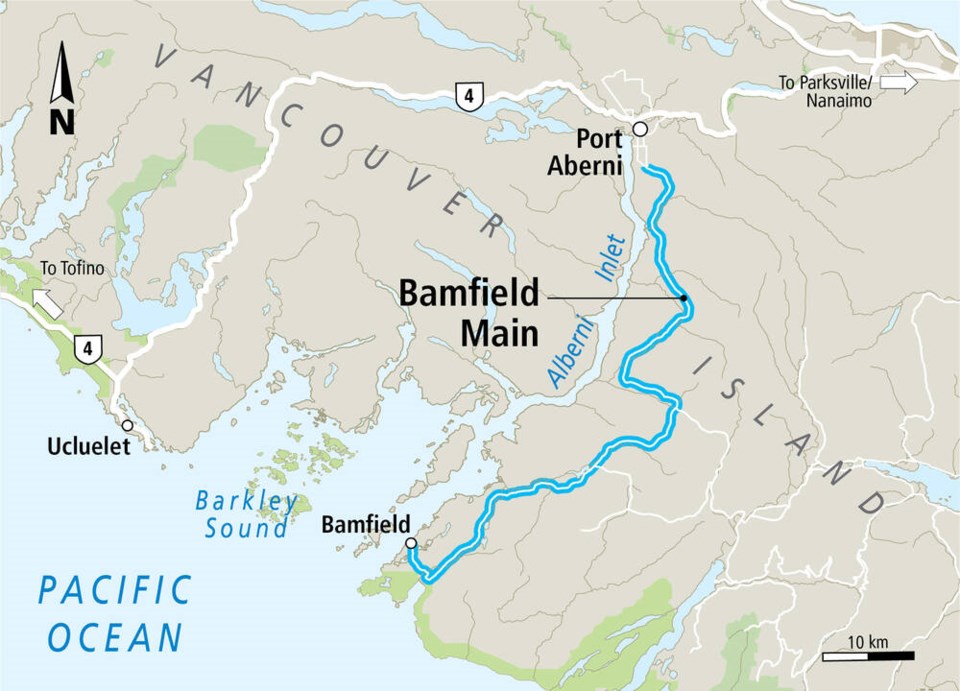A three-year project to improve a rough and dangerous road that links Port Alberni with Bamfield will bring new economic opportunities to First Nations and give its members and the wider public a sense of safety to explore the territory, says the chief elected councillor of the Huu-ay-aht First Nation.
“The economic impacts of tourism as we share our lands and culture helps everyone,” John Jack said in an interview Friday. “It helps our people get to medical appointments and the things they need and it will help others like plumbers and carpenters get to Bamfield safely. The new road improvements are really important for everyone.”
The Bamfield Main road project is in the final phase. Work to apply chip-seal coating on the 76.6-kilometre route starts Saturday and will continue through to the fall, so drivers can expect delays with alternating single-lane traffic guided by pilot vehicles.
The initial phase of road coatings will start from kilometre 36 and go to Bamfield. When that section is complete, surfacing will resume from kilometre 36 and proceed to Port Alberni.
Jack said a detour will be in place for the initial sealing work at kilometre 36 where vehicles can wind around the work and emerge at kilometre 49.
Chip-seal coating involves applying a base of hot tar onto the existing roadway, which is then embedded with fine-grade aggregates.
Jack said the coating is designed to address persistent problems that make the road dangerous, such as potholes and wash-boarding.
The $30-million project is a partnership with the province and the Huu-ay-aht First Nation, and is considered a historic undertaking in British Columbia as the first Indigenous community to lead a major road infrastructure project of this size.
Huu-ay-aht executive councillor Wiiheyakchikk, Brad Johnson said the road improvements will provide safety for Huu-ay-aht citizens, the Bamfield community and visitors.
“That is one of our main priorities,” said Johnson, adding a better road will also bring economic benefits to the region and a sustainable economy for the Huu-ay-aht Nation.
The 76.6-kilometre Bamfield Main includes about 60 kilometres of road owned by Western Forest Products and 18 owned by Mosaic Forest Management, the Huu-ay-aht First Nations and the Ministry of Transportation.
It has been the site of at least 12 traffic deaths involving Huu-ay-aht members over the years and the high-profile bus crash that claimed the lives of two University of Victoria students in 2019. UVic operates the Marine Sciences Centre at Bamfield and the students were travelling there for field work when the bus crash occurred.
After the bus crash, the province struck a working group with the Huu-ay-aht and forest companies to explore safety upgrades.
Derek Peters, whose grandfather, Art Peters, died in a crash on Bamfield Main several years ago, said his Nation was “forever changed” with the loss. “It is tragic that it took the loss of so many to highlight the need for chip-sealing the road, but we honour the ones we have lost by doing everything we can to prevent the loss of life along this vital link in the future.”
Jack said Art Peters was instrumental in leading the Huu-ay-aht in treaty work and involving the Nation in logging, one of its main sources of income and jobs. He said the new road builds on another one of Peters’ “pillars” that has made the Huu-ay-aht a stronger Nation.
The province contributed $25.7 million to the project. Huu-ay-aht paid the additional $5 million and managed the project. Huu-ay-aht provided in-kind resources, including gravel from several pits the Nation developed on its treaty lands, which resulted in significant cost savings for the project.
Jack said some sections of Bamfield Main have been widened and other parts have been raised in areas of winter flooding. New ditching was excavated along the road to protect against rainwater drainage and about 300 culverts were installed.
The road top was finished with hard compacted gravel and is ready for chip seal coating.
Steel guard rails have been added in some sections — including the site of the bus crash — and layers of rocks and boulders have been laid on roadsides that skirt lakes and rivers to avoid erosion, said Dick.
Concrete barriers line approaches to the 20 single-lane bridges.
Jack noted new concrete box culverts are in place near Fredrick Lake to allow the at-risk western toad population free movement under the road.
The province and Huu-ay-aht identify the work as a reconciliation project.
Minister of Indigenous Relations and Reconciliation Murray Rankin called it a vital roadway connecting residents of several coastal communities.
“I commend Huu-ay-aht First Nations for their steadfast commitment and continued progress on such a large-scale project,” Rankin said. “This project will ensure Bamfield Main is a safe route for everyone.”
>>> To comment on this article, write a letter to the editor: [email protected]



